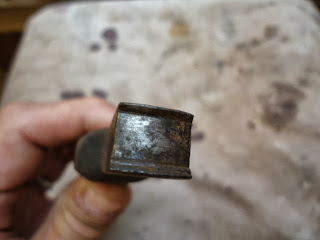First off congratulations to Frances, Marco and Mathilde who finished their two-week intensive last Saturday. There were some beautifully finished edges, so much so, that one student was allowed to do a natural finish! See the results for yourselves.
More and more students want to keep on making, but how much room do you need to set up a shoemaking bench? Well. when we first arrived at Gieves & Hawkes we luxuriated in the 'goldfish bowl' on the shop floor, giving visitors to No.1 a glimpse into the world of Cordwaining. Three years later, we now have a beautiful display of bespoke shoes on the shop floor and we have joined the cutters in the heart of the store's tailoring workrooms.
It is a great working environment and we were fortunate to have a bright, airy space purpose-built to our needs. In terms of space, you really don't need very much, but it is good to use walls and ceilings to their utmost. Good light, ventilation and a sink are a must.
Space wise, you need room to open your arms to their maximum and space to sit behind a low table. Our new space measures some 3m square and incorporates rails overhead to carry our clients' lasts and bends of leather...
a desk for stationery, packing materials, our measuring kit, first aid kit, laptop and telephone. (Underneath is room to store leather samples and laces).
A workbench and chair, standing some 75cm high, with tools in pots and hung from the table edges, a spotlight for close work...
and less-often used tools and materials stored in the antique drawers to the side. Purpose-built shelves to the opposite side, house some of the work in progress waiting to be delivered and for fittings.
Our contact adhesives and burner are stored in a special fire-proof/chemical store cabinet...and other tools and templates are hung on the wall partly as a display, but also within easy reach from the bench.
Hand-held tools are an important part of the storytelling around our brand and product - after all, they are what we use every day to make our shoes - so it is irksome when other brands try to claim a handmade element in their marketing. The example below is case in point. Can anyone guess which brand these 'handmade' shoes are from?
You'll know what we mean when you see them in reality...fortunately we think that most customers are discerning enough to recognise the authentic from the inauthentic.
Until next week, happy shoemaking!
Until next week, happy shoemaking!





































